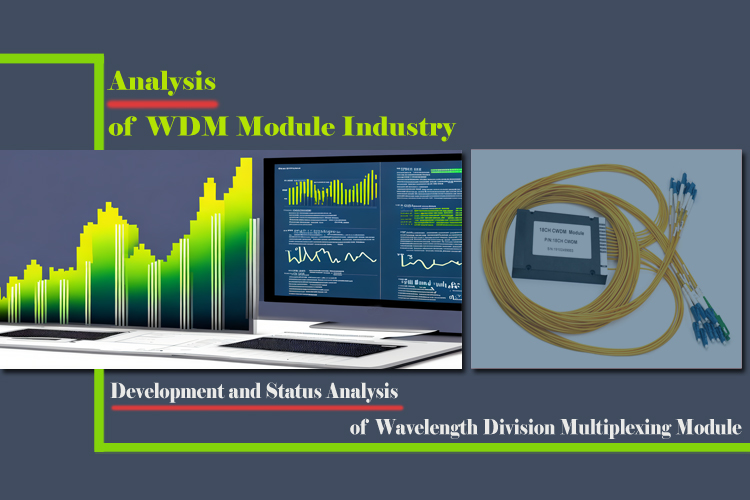Detailed Analysis of WDM Module Industry
Development and Status Analysis of Wavelength Division Multiplexing Module
I. Executive Summary
This detailed analysis report on the WDM (Wavelength Division Multiplexing) module industry aims at providing understanding perception the product classification, application, industry policies, industry chain, production mode, sales mode, favorable factors, and unfavorable factors of the industry’s development and entry into new markets.

II. Product Classification
WDM modules can be classified into two main categories based on their functionality and application:
1. Coarse Wavelength Division Multiplexing (CWDM) Modules: These modules use a wider wavelength spacing, which allows the transmission of data over a longer distance at lower costs.
2. Dense Wavelength Division Multiplexing (DWDM) Modules: These modules have tighter wavelength spacing, enabling more channels to be incorporated and thus offering higher capacity and longer reach. They are more suitable for high-capacity and long-haul communication.
III. Application
WDM modules are widely used in various sectors, including:
1. Telecommunications: Improving capacity and efficiency in core, metro, and access networks.
2. Data Center Interconnectivity: Offering a high-capacity and low-latency solution for connecting data centers over short and long distances.
3. Enterprises: Used in private networks, campus systems, and other applications that require a secure and high-speed data transfer.
4. Government and Defense: WDM modules can enhance the capacity and security of communication links for government agencies and military institutions.
IV. Industry Policy
Several regulatory bodies and standards organizations oversee the development, production, and implementation of WDM modules. These include:
1. International Telecommunication Union (ITU): Sets global standards for WDM technology.
2. Institute of Electrical and Electronics Engineers (IEEE): Develops standards for optical communication components, including WDM modules.
3. Federal Communications Commission (FCC) and European Telecommunications Standards Institute (ETSI): Regulate the deployment and usage of WDM technology in specific regions.
V. Industry Chain
The WDM module industry chain mainly comprises the following stages:
1. Component and Material Suppliers: Provide essential materials and components, including lasers, detectors, modulators, and filters.
2. WDM Module Manufacturers: Design, develop, and produce WDM modules based on the components and materials.
3. System Integrators: Incorporate WDM modules into various communication equipment, such as optical transport systems and switches.
4. Network Operators and Service Providers: Deploy, maintain, and manage WDM-based networks.
5. End-users: Utilize the WDM-based systems for their specific applications.
VI. Production Mode
Production mode in the WDM module industry involves a combination of in-house manufacturing and collaborative partnerships. Some businesses produce the entire product, while others focus on specific components or outsource some parts from specialist manufacturers. Assembling and packaging may be managed internally or through partnerships with external contract manufacturers.
VII. Sales Mode
Different sales channels are used in the WDM module industry, including direct sales, distributors, and online platforms. Many businesses adopt a combination of these channels to reach a broader customer base.
VIII. Favorable Factors
1. Growing demand for high-capacity and efficient communication networks.
2. Increase in data traffic resulting from the Internet of Things (IoT), cloud computing, and big data analytics.
3. Technological advancements and innovations in WDM module design.
4. Government support and investment in telecom infrastructure development.
IX. Unfavorable Factors
1. High initial investment and deployment costs.
2. Complexities in the integration of WDM technology.
3. Reliance on imported components and materials for some businesses, resulting in supply chain vulnerabilities.
4. Intense competition among industry players.
X. Entering New Markets
Entering new markets in the WDM module industry poses several challenges, including:
1. Understanding regional market dynamics and customer requirements.
2. Complying with local regulations and industry standards.
3. Building a local presence through partnerships, collaborations, or acquisitions.
4. Managing supply chain complexities and adapting the production process.
To succeed in new markets, thorough market research, a robust entry strategy, and effective implementation are essential.
XI. Conclusion
This analysis offers a comprehensive perspective on the WDM module industry and highlights various aspects crucial for businesses. By understanding the product classification, application, industry policies, industry chain, production mode, sales mode, favorable and unfavorable factors, and strategies for entering new markets, businesses can navigate the complex landscape of the WDM module industry and make informed decisions to achieve sustainable growth.
Recommended Reading:High-Speed WDM System for 5G Support

 The Future of Fiber Optic Communication Network Architecture: Evolution and the Role of SDON Technology
The Future of Fiber Optic Communication Network Architecture: Evolution and the Role of SDON Technology
 What opportunities and challenges does free-space optical communication technology face?
What opportunities and challenges does free-space optical communication technology face?
 Opelink MPO Products for High-Speed Data Center Applications
Opelink MPO Products for High-Speed Data Center Applications
 CWDM vs. DWDM: Which Optical Transmission Technology Should You Choose?
CWDM vs. DWDM: Which Optical Transmission Technology Should You Choose?